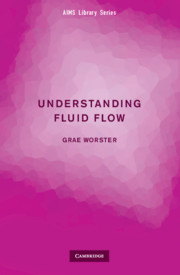3 - Viscous gravity currents
Published online by Cambridge University Press: 30 April 2024
Summary
We are now in a position to calculate the flow of syrup poured onto a horizontal surface, as measured in our second experiment. This is a significant problem that brings together all the ideas we have met so far. We’ll start by considering a two-dimensional version of the problem, as shown in Figure 15.
We’ll assume that because the current is long and thin the flow is almost parallel, so u = (u(y, t), 0), and we can use the equations of parallel flow
We start by estimating the sizes of the terms in the first equation. Suppose that the characteristic scale for variations in the x direction is L and in the y direction is H, that the characteristic velocity scale is U and that therefore the characteristic time scale for spreading is T = L/U. In the first equation above, the left-hand side represents the inertia of the fluid, and the first term on the right-hand side represents the viscous stresses. Using the characteristic scales, the ratio of these terms is
Therefore, from a formal (asymptotic) viewpoint, the inertial term can be neglected relative to the viscous term if UH2/νL ≪1 (very small). From a practical point of view, we can estimate that the velocities in our experiment were never more than about 10 cm s−1, the thickness was about 1 cm and the length about 10 cm. The kinematic viscosity of golden syrup at 20°C is about 500 cm2 s−1. These estimates give UH2/νL ≈ 2 × 10−3 at most, so it is a very good approximation to neglect inertia in our analysis of the experiment. By integrating the momentum equation in the y direction, we find that the pressure
Note that the pressure is equal to the atmospheric pressure patm at the top surface of the current, where y = h. The momentum equation in the x direction and the associated boundary conditions are then
Just as in the case of a wind stress driving flow in a lake, the elevation h(x, t) of the free surface is determined by a constraint on the volume flux. In the present case we have the constraint that the total volume of fluid is fixed, so that
where xN is half the length of the current.
- Type
- Chapter
- Information
- Understanding Fluid Flow , pp. 25 - 36Publisher: Cambridge University PressPrint publication year: 2009

